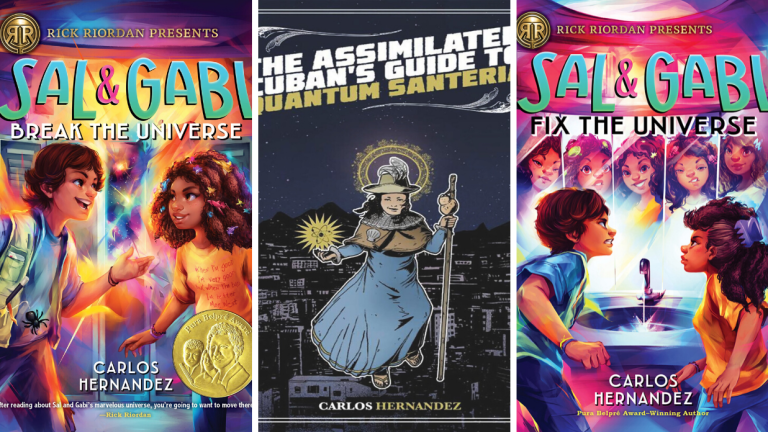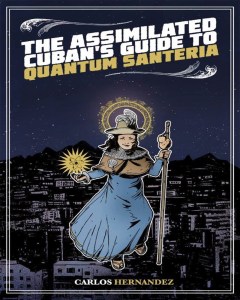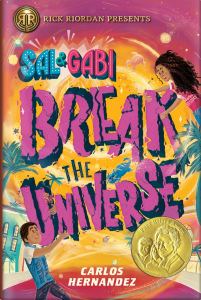An Introduction to Carlos Hernandez’ Sal & Gabi
Explore the multiverse with Carlos Hernandez' Sal and Gabi series.

If you don’t read middle-grade fantasy, you may have missed out on reading the excellent fiction of Carlos Hernandez. His second middle-grade novel, Sal and Gabi Fix the Universe, sequel to last year’s Sal and Gabi Break the Universe (which was one of Den of Geek’s Best Books of 2019), has just been released through the Rick Riordan Presents imprint. But even if you don’t read middle grade novels, Hernandez is an author to watch.
Hernandez has written more than 30 works of fiction, poetry, and drama, not to mention game design—he served as one of the lead writers in the historical role playing game Meriwether: An American Epic. You can find him in Uncanny, The Years Best Science Fiction and Fantasy 2017, and in his multiverse bending collection, The Assimilated Cuban’s Guide to Quantum Santeria. If you’ve yet to pick up any of those, “Phew, Baby,” as one of Hernandez’s characters would say, you’re in for a ride…

Quantum Santeria
Sal and Gabi didn’t originate as middle school characters. Both characters, in adult incarnations, from another part of the multiverse, appear in the collection The Assimilated Cuban’s Guide to Quantum Santeria. There, Gabby is a reporter for a newspaper that covers the weird and wacky, including panda robots that help real pandas procreate, multiverse hopping unicorns, and a piano that may be carrying the soul of the world-class pianist who performed on it. Salvador is a physics professor who posits that time is multiple dimensions—and who, with the help of practicing Santeria, has broken through the multiverse.
The short stories in the collection don’t always end happy, and they frequently surprised me before they concluded, taking a left turn just before the end when I thought I’d known where they were going. If that kind of surprise doesn’t keep readers turning pages, then Hernandez’s quirky way of looking at the world certainly will. He plays with the multiverse in several stories, giving a wounded vet a chance to walk on legs as long as he’s within a lab where parts of the multiverse can be borrowed and replicated, or having multiverse-hopping extraterrestrials encounter an overly-enthusiastic border guard patrolling for illegal aliens. There’s also a reality television show about hit men that ends in real murder, immortal jellyfish on Mount Everest, scientists on a space station working to save the ecosystem of a new human home before we can destroy it, and an attempt to put the long-dead spirit of a mother into an object that will allow her to communicate with her son.
The stories span many themes and subgenres of science fiction and fantasy, many of them drawing on Hernandez’s Cuban heritage. But while the window dressing in each of the stories is unique, they have, at their core, stories of human love and loss, family relationships, and moments of betrayal and repentance. They’re beautiful and strange and heartbreaking, and they’ll resonate well after you’ve closed the pages of the book.

Sal and Gabi
For readers who grew up on, or whose kids grew up on, the “Percy Jackson” series (the books, not the films, whose existence I shall deny), Riordan is a household name. In interviews, Hernandez has praised the luck that brought him to the attention of Riordan, who invited him to submit an idea to a then-newly-formed imprint for #OwnVoices middle grade fantasy novels. While most of the series published through Rick Riordan Presents are mythology focused, with gods and demigods running around, some have taken a more science fiction approach, including Yoon Ha Lee’s fantastic space fantasy Dragon Pearl and Hernandez’s own “Sal and Gabi” books, which borrow some of the same ideas he has explored in his multiverse-bending short stories.
In Sal and Gabi Break the Universe, seventh grader Sal begins his career at a new middle school by combating a bully—not by fighting back exactly, but by performing a magic trick of sorts. While Sal is a stage magician, and quite good at it, he also has an uncanny ability to be able to relax and view the multiverse. Sometimes, he can pull things through. In the case of the bully, this means pulling a dead chicken out of the bully’s locker. Ta da! It diffuses the bullying situation like a charm.
Unfortunately for Sal, in his heart of hearts, he misses his mother, who died when he was eight, and sometimes he brings a different version of her into his universe. It never goes well. But Sal can’t stop missing his Mami, and he doesn’t seem able to stop bridging the multiverse to see her, so his father, a calamity physicist, is working on a remembranation machine that will keep the multiverse from being so permeable. Meanwhile, Gabi, Sal’s new and soon-to-be-best friend, helps Sal approach the multiverse situation with totally fresh eyes—and that new perspective may mean everything when it comes to saving someone the kids both care about.
The quest to make things right with the multiverse continues in Sal and Gabi Fix the Universe, only here, we realize that the stakes are bigger than anyone realized: if the multiverse becomes completely impermeable, it could wipe out reality all across the multiverse. It’s up to Sal and Gabi—or, at least, one version (or more) of Gabi from elsewhere in the multiverse—to save everything. (And, meanwhile, they also have to save back to school night from being dreadfully boring. Because while saving the multiverse is important, middle school at one of the coolest schools in the multiverse must go on.)
The success of Into the Spiderverse with young viewers and adults alike makes it clear that middle graders have no trouble navigating the concept of the multiverse. But, just like adult viewers were hooked on that film, the “Sal and Gabi” novels have a lot going on for adult readers. Sal is at once a totally authentic seventh grader, making the kinds of bad (and good!) choices that a seventh grader really would make, but he’s also wise beyond his years. Some of that comes from having experienced death at a young age, but some of it also comes from his ability to “branesurf,” to see the multiverse for the wide, expansive place that it is.
Gabi, too, manages to be exactly a middle schooler and also well above adult expectations for that grade level. She’s the type of student who not only exceeds every expectation, but also manages to, in the guise of student body president, perform as the lawyer for students in need of representation when facing down the principal. (The principal is so amazing it’s hardly necessary, but Gabi’s initial appearance showcases her mad courtroom skills.) The Gabi in this part of the universe seems at least as likely to become president as an adult as she does become a weird-news reporter, and the nation would be in very capable hands.
Along with the main characters, Hernandez’s world is populated with genuine characters (both human and artificial intelligences) who are talented, clever, and good-hearted, without ever being too-good-to-be-true. The novel is full of found family, and embracing different ways to belong with the people you love. You’ll believe, after reading these novels, that the world is full of good people, who just have to find each other and a way to work together in order to fix the multiverse.
I don’t know about you, but that’s the kind of story I need right now.
